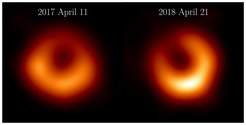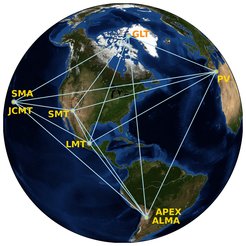New EHT observations of M87 reveal persistent black hole shadow
Improved observations one year after the discovery image give a better picture
The Event Horizon Telescope (EHT) Collaboration, with the significant contribution of researchers at the MPI für Radioastronomie, has released a new image of M87*, the supermassive black hole residing at the heart of the galaxy Messier 87. This latest revelation builds upon the historic 2019 release, marking the first-ever image of a black hole. The 2018 EHT observation campaign showcases a persistent black hole shadow, offering crucial insights into the nature of M87*. The new image, captured with an improved telescope array and a broader frequency coverage, reveals a ring with a southerly peaked brightness distribution, akin to the 2017 image, but with a subtle difference: a remarkable shift in the brightness asymmetry, rotated by approximately thirty degrees, has been identified.
The research is published in the present issue of the Astronomy & Astrophysics journal.

“A fundamental requirement of science is to be able to reproduce results,” says Dr. Keiichi Asada, an associate research fellow at Academia Sinica Institute for Astronomy and Astrophysics in Taiwan. “Confirmation of the ring in a completely new data set is a huge milestone for our collaboration and a strong indication that we are looking at a black hole shadow and the material orbiting around it.”
"In the field of black hole astrophysics, this new image is a testament to the persistence and stability of M87*'s shadow. The intriguing rotation in the brightness asymmetry gives us confidence in our understanding of the accretion flow," says Michael Janssen, affiliated with MPIfR and recently appointed Assistant Professor of Astrophysics at Radboud University in Nijmegen, who was responsible for the data calibration and coordinated the publication.
In 2017, the EHT obtained the first image of a black hole, revealing M87* as the beating heart of a giant elliptical galaxy, located 55 million light-years from Earth. This first image, published in 2019, shows a bright circular ring, brighter in the southern part of the ring. Further analysis of the data also revealed the structure of M87* in polarized light, giving us greater insight into the geometry of the magnetic field and the nature of the plasma around the black hole.
The decision to re-observe M87* in 2018 was driven by the wish for a deeper understanding of the nature of the source, its variability, and also by the availability of much improved improved observational and technical capabilities. Thomas Krichbaum, an MPIfR senior scientist and EHT collaboration member, who contributed to the imaging of the newly presented data, explains: "Repeated observations of M87* allow us to study the kinematics of the matter flow towards the black hole and to separate the complex physics of radiation production from the geometric effects of general relativity. This is a further step towards a better understanding of black hole phenomena."
To enhance observing capabilities, the Greenland Telescope joined the EHT in 2018, just five months after its construction was completed The Greenland Telescope is located far above the Arctic Circle, providing improved image fidelity and increased angular resolution in the north-south direction. The Large Millimeter Telescope in Mexico also participated for the first time with its full 50-metre surface, greatly improving its sensitivity. In 2018, the EHT array was also upgraded to observe in four frequency bands around 230 GHz, compared to only two bands in 2017. Despite the challenges posed by weather conditions during the 2018 observations, advances in data acquisition and calibration techniques ensured high-quality results.
The analysis of the 2018 data, using eight independent imaging and modeling techniques, reaffirms the stability of the diameter of the black hole shadow, consistent with general relativistic predictions. However, a significant change in the location of the brightest region around the ring shows turbulence breaking the symmetry, combined with a dynamic interplay between the black hole's spin axis and the large-scale jet.
A recent publication presented in October 2020 (ApJ 901, 67) led by Maciek Wielgus from the MPIfR reported changes in the location of the ring brightness. He comments: “In our paper we concluded that M87* should persistently appear as a ring, with little variation of the ring diameter, and more variability of the brightness maximum location. We compared this behavior to a 'wobbling' of the black hole shadow image. These predictions were based on the analysis of the archival data from a less advanced pre-EHT array of telescopes and on theoretical arguments." He adds: "It's great to see our predictions confirmed with the significantly improved EHT instrument, able to deliver much richer and more constraining observations.”
"This latest discovery brings us into a new era of black hole research. The continuous improvement of our observational tools, combined with years of data accumulation, promises even more exciting revelations in the future," notes Eduardo Ros, also a scientist at the MPI für Radioastronomie and a member of the EHT collaboration, underlining the collaborative effort of the international scientific community. "These data at 1.3 mm wavelength complement the recently presented 3.5 mm data from April 2018, which show both the black hole shadow and the jet," he adds. All these data have been processed partially or totally at the MPIfR correlator facility.
As the EHT begins scheduling its coming annual observations for April 2024, the scientific community is eagerly anticipating the unravelling of more mysteries surrounding M87* and the enigmatic realm of black holes. Anton Zensus, founding chair of the EHT collaboration and director of the MPIfR, reflects on his institute's pivotal role: "Our institute has been integral from the beginning of the observational design to the culmination of the final results. Notable contributions include the meticulous analysis of 50% of the data performed in our Correlation Processing Centre, the supervision of the participating APEX and IRAM 30-metre telescopes, and the extensive calibration and imaging efforts performed in-house".

Additional Information
The EHT collaboration involves more than 300 researchers from Africa, Asia, Europe, and the Americas. This international alliance aims to capture unprecedentedly detailed images of black holes by building a virtual Earth-sized telescope. Leveraging significant global investment, the EHT is linking existing telescopes through innovative systems to create a revolutionary instrument with the highest angular resolution to date.
The telescopes contributing to this endeavor include ALMA, APEX, the IRAM 30-meter Telescope, the IRAM NOEMA Observatory, the James Clerk Maxwell Telescope (JCMT), the Large Millimeter Telescope (LMT), the Submillimeter Array (SMA), the Submillimeter Telescope (SMT), the South Pole Telescope (SPT), the Kitt Peak Telescope (KP), and the Greenland Telescope (GLT). Data have been post-processed at correlator facilities at the MPIfR in Bonn and MIT/Haystack Observatory in Westford, MA, USA. Further analysis was performed in the framework of the global EHT collaboration.
The EHT consortium comprises 13 stakeholder institutes, namely the Academia Sinica Institute of Astronomy and Astrophysics, the University of Arizona, the University of Chicago, the East Asian Observatory, Goethe-Universitaet Frankfurt, Institut de Radioastronomie Millimétrique, Large Millimeter Telescope, Max Planck Institute for Radio Astronomy (MPIfR), MIT Haystack Observatory, National Astronomical Observatory of Japan, Perimeter Institute for Theoretical Physics, Radboud University, and the Smithsonian Astrophysical Observatory.
Researchers affiliated with the MPI für Radioastronomie, listed as co-authors in the published research, are Walter Alef, Rebecca Azulay, Uwe Bach, Anne-Kathrin Baczko, Silke Britzen, Gregory Desvignes, Sergio A. Dzib, Ralph P. Eatough, Christian M. Fromm, Michael Janssen, Ramesh Karuppusamy, Jae-Young Kim, Joana A. Kramer, Michael Kramer, Thomas P. Krichbaum, Mikhail Lisakov, Jun Liu, Kuo Liu, Andrei P. Lobanov, Rusen Lu, Nicholas R. MacDonald, Nicola Marchili, Karl M. Menten, Cornelia Müller, Hendrik Müller, Georgios Filippos Paraschos, Eduardo Ros, Helge Rottmann, Alan L. Roy, Tuomas Savolainen, Lijing Shao, Pablo Torne, Efthalia Traianou, Jan Wagner, Robert Wharton, Maciek Wielgus, Gunther Witzel, J. Anton Zensus, and Guang-Yao Zhao.

